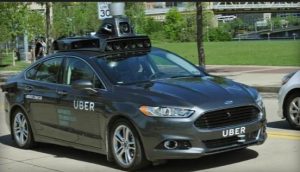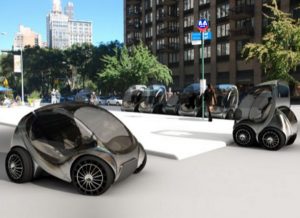Here’s part two of my analysis of 2016 events and a forecast of 2017 trends in clean transportation and mobility:
Autonomous vehicles:
 Michigan now leading the way: Last month, Michigan Gov. Rick Snyder signed a package of bills to clear the way for self-driving cars to operate on public roads and re-establish the state as the leader in automotive innovation. The Michigan bills establish regulations for the testing, use, and eventual sale of autonomous vehicle technology, and were crafted to more clearly define how self-driving vehicles can be legally used on public roadways. The new laws allow testing of vehicles without steering wheels, pedals, or needed human control – which aims to propel Michigan ahead of California, which had been the leading state in the U.S. for testing autonomous vehicles.
Michigan now leading the way: Last month, Michigan Gov. Rick Snyder signed a package of bills to clear the way for self-driving cars to operate on public roads and re-establish the state as the leader in automotive innovation. The Michigan bills establish regulations for the testing, use, and eventual sale of autonomous vehicle technology, and were crafted to more clearly define how self-driving vehicles can be legally used on public roadways. The new laws allow testing of vehicles without steering wheels, pedals, or needed human control – which aims to propel Michigan ahead of California, which had been the leading state in the U.S. for testing autonomous vehicles.
The federal government is going in that direction as well, issuing long-awaited guidelines backing fully autonomous vehicles in September. The U.S. Department of Transportation would like to see uniform, national policies applying to autonomous vehicles. In a joint appearance, Anthony Foxx, secretary of the U.S. Department of Transportation and Jeffrey Zients, director of the National Economic Council, released guidelines that encourage technology innovations from companies balanced with concerns over public safety.
Uber continued testing its self-driving vehicles in Pittsburgh, but decided to move from California to Arizona. Uber last month used Otto flatbed trucks to move its autonomous Volvo cars to Arizona after the California Department of Motor Vehicles revoked registration of the company’s self-driving cars. California had made regulatory threats to Uber, and things got worse when the ride-hailing company refused to purchase $150 permits for testing autonomous cars that the state requires. There may be more than the 16 self-driving vehicles that had been tested by Uber in San Francisco, and the company hasn’t provided a date on when testing will begin in Arizona.
Google has renamed its Self-Driving Car Project as “Waymo.” Waymo will be an independent unit within the Alphabet parent company. While the company had previously been an advocate of fully autonomous vehicles without steering wheels or pedals, it may be backing away from that stance. Google co-founder Larry Page has been reported to be rethinking his company’s mission. Alphabet/Google, along with Apple, are now looking into partnering with automakers as technology suppliers rather than investing heavily, and going through the complex regulatory process, needed to manufacture their own autonomous vehicles.
Honda has been in talks with Waymo to test out some of the autonomous vehicle technology in Honda’s vehicles. Both companies said that it’s a research project and not a manufacturing agreement to jointly manufacture autonomous vehicles. Honda may choose to provide Waymo with vehicles that are modified to run on Google’s self-driving system; those Honda vehicles would join the existing Waymo test vehicles currently being tried out in four U.S. cities.
Honda follows Fiat Chrysler Automobiles in creating a self-driving vehicle test program. FCA announced in December that it has completed building 100 minivans that are being outfitted with autonomous vehicle equipment for Waymo. The Chrysler Pacifica Hybrids (plug-in hybrid vehicles) recently were completed at the automaker’s Windsor Assembly Plant. Google and parent company Alphabet have also been reported be in talks with FCA about starting up a ride-hailing and ridesharing service using Chrysler Pacifica minivans.
Tesla Motors is planning to demonstrate a Tesla vehicle traveling cross country in fully autonomous mode by the end of 2017. During a fall conference call announcing fully autonomous capable hardware, CEO Elon Musk said the company’s goal is to demonstrate a vehicle traveling safely from Los Angeles to New York using the new technology by the end of this year. The software for reaching the fully self-driving mode will need to be validated and approved by regulators before being released to the public. Model S and Model X vehicles equipped with hardware for full autonomy are already in production, and the upcoming Model 3 will have it as well, Musk said. Semi-autonomous features will continue to be available through the Autopilot feature, but Tesla has separated Autopilot from the new fully autonomous features after the fatal crash in Florida was reported last summer. If all of this works out and receives government approval, Tesla would likely lead the market in autonomous technologies. Tesla may have a fully automated vehicle for sale by 2018, beating Ford and BMW, which have committed to rolling out fully autonomous vehicles by 2021.
China would like to become the world’s largest market for plug-in and autonomous vehicles. The Chinese government released a policy report on setting national standards for autonomous vehicles. It’s taking an optimistic approach: “partially autonomous,” will make about 50% of new vehicle sales in China by 2020. “Highly-automated” cars (close to being fully automated) will make up 15% by 2025; and fully autonomous vehicles will account for 10 percent of new vehicle sales by 2030, according to the report. The report also forecasts that “new energy vehicles” (plug-in hybrid and all-electric vehicles) will make up 40% of the 38 million new vehicles sold in China during 2030. That would make for about 15 million new plug-in vehicles coming to market that year. By 2030, the report expects to see “new energy vehicles” (plug-in hybrid and all-electric vehicles) make up 40 percent of the 38 million new vehicles that will be sold in China during 2030, or about 15 million units.
Impact of autonomous vehicles on fuel consumption: Massachusetts Institute of Technology (MIT) engineers have conducted a study of a vehicle-platooning scenario and determined the best ways to deploy vehicles in order to save fuel and minimize delays. Their analysis, presented last month at the International Workshop on the Algorithmic Foundations of Robotics, shows that relatively simple, straightforward schedules may be the optimal approach for saving fuel and minimizing delays for autonomous vehicle fleets. The findings may also apply to conventional long-distance trucking and even ride-sharing services. Navigant Research may not agree with those findings. Navigant just released a study which analyzed how fuel is likely to be affected by the growing use of automated mobility systems in light-duty passenger and medium-to-heavy duty goods vehicles. Usage of petroleum and alternative fuels is likely to go up with growing transportation demand in developing nations like China and India; and in developed countries that are seeing surging demand for mobility services and automated systems.
Urban mobility
 Automakers took serious steps forward during 2016 showing their commitment to mobility services and the changing identity of automakers in the near future.
Automakers took serious steps forward during 2016 showing their commitment to mobility services and the changing identity of automakers in the near future.
GM’s investment in carsharing brand Maven, along with $500 million in Lyft and $1 billion acquisition of Cruise Automation, seemed to start the trend. GM will be testing self-driving versions of the Chevy Bolt all-electric car with Lyft. Maven is considered to be a serious competitor to Zipcar and other carsharing services.
Ford Motor Co. last year acquired shuttle service Chariot and forged a partnership with bike-share program Motivate. The automaker sees the importance of tapping the market value by turning to low-fixed cost and less capital revenue streams like Chariot and Motivate, said Ford executive chairman Bill Ford. In March, the company the creation of Ford Smart Mobility LLC, a new subsidiary formed to design, build, grow and invest in emerging mobility services.
Toyota launched a Mobility Services Platform (MSPF) to support emerging mobility services like carsharing. The platform will be used to collaborate with service providers and telematics insurance carriers. In May, Toyota and Uber forged an alliance that will create new leasing options. Car buyers can lease their vehicles from Toyota Financial Services and cover their payments through earnings generated as Uber drivers. Toyota also created another alliance tied to the launch of MSPF with U.S. carsharing company Getaround. The two companies will start a pilot program this month in San Francisco.
BMW is moving its ReachNow carsharing service forward. During the L.A. Auto Show’s AutoMobility days, BMW announced that four new services will be launched in four North American cities. A new ridesharing service competes with Uber and Lyft and offers members an on-demand ride service where a driver shows up with a car. ReachNow Ride was scheduled to start up as a pilot program in Seattle last month, and it will be available to all members in early 2017.
Tesla Motors will launch Tesla Network with self-driving capabilities in 2017. In his “Master Plan, Part Deux” in July, Tesla CEO Elon Musk included a system in which a Tesla owner could add a car to a shared Tesla fleet using a mobile app. That’s where Musk introduced the concept of the Tesla Network where the electric automaker will be entering into ridesharing and carsharing services that will be a revenue model for Tesla. The company has been released a few more details lately on its blog and website. Tesla doesn’t want its car owners to use these electric cars for Uber and Lyft rides. “Please note that using a self-driving Tesla for car-sharing and ride-hailing for friends and family is fine, but doing so for revenue purposes will only be permissible on the Tesla Network, details of which will be released next year (2017),” according to a recent Tesla website statement.
Volkswagen made a series of announcements as it emerges from the “Dieselgate” scandal and commits to vehicle electrification and globally competitive mobility services. The German automaker kicked things off earlier this year by investing $300 million in on-demand transportation service Gett. At that time, the cab-hailing startup had operations across about 60 cities around the world. The German automaker also launched its Moia brand last month, stating that it expects it to become one of the largest mobility providers in the world. The new business will initially offer electric ride-hailing and carsharing services. Electric shuttles will likely be the first fleet vehicles rolled out to customers and they’ll soon be automated, the company said. VW also bought Vancouver-based parking-payment operator PayByPhone, which processed more than $250 million in transactions this year. The automakers wants to become the leader in mobile payments for parking. VW’s financial services unit had previously taken a 92 percent stake in Sunhill Technologies GmbH, Germany’s market leader for mobile parking payments. Another recent announcement by VW was adding a ride-hailing service in Rwanda as part of its mobility services to compete with Uber’s strong presence in Africa and other regions.
Infrastructure
 The Federal Highway Administration released a map in November showing 55 routes across the U.S. for charging plug-in vehicles and refueling alternative fuel vehicles, with 48 designated charging routes in the new corridor. The Alternative Fuel Corridors covers 35 states and nearly 85,000 miles, according the U.S. Department of Transportation’s FHWA. More miles will be added to the network to accommodate electric, hydrogen, propane autogas, and natural gas vehicles as more alternative fueling and charging stations are built.
The Federal Highway Administration released a map in November showing 55 routes across the U.S. for charging plug-in vehicles and refueling alternative fuel vehicles, with 48 designated charging routes in the new corridor. The Alternative Fuel Corridors covers 35 states and nearly 85,000 miles, according the U.S. Department of Transportation’s FHWA. More miles will be added to the network to accommodate electric, hydrogen, propane autogas, and natural gas vehicles as more alternative fueling and charging stations are built.
The designation of these corridors comes from the “Fixing America’s Surface Transportation” (FAST) Act, which was signed by the president in December 2015. In July, U.S. Transportation Secretary Anthony Foxx put the alternative fuel station provision in motion by calling on states to nominate national plug-in electrified vehicle charging and hydrogen, propane, and natural gas fueling corridors along major highways.
You can view an Alternative Fuel Corridors resources page that includes a map showing each of the charging and fueling networks. There’s only one electric charging route linking the nation, which crosses the Great Plains with Highway 70 bridging between Utah and Colorado. Charging station routes are concentrated in the Northeast, East Coast, Great Lakes region, Texas, and the West Coast. Compressed natural gas will have corridors very similar to charging networks. Hydrogen fueling routes will be concentrated in California, Colorado, the Midwest, and the Northeast.
Electric vehicle charging network EVgo kicked off the nation’s quickest fast-charging station in Baker, Calif., at the site of the World’s Tallest Thermometer. Drivers going from Los Angeles and Las Vegas can see how hot it’s getting out there, and can pull over for a very fast charge. These days,
50-kW CHAdeMo or Combined Charging System (CCS) fast chargers are about as fast it gets. EVgo has started constructing a 350-kW fast charging station in Baker. The charger company says that these chargers will be seven times faster than any fast chargers currently available, and that they represent a new level of convenience. Electric vehicles with the biggest battery packs that travel the farthest per charge will be able to get 80% charged in less than 20 minutes.
Renewable fuels and energy
 Renewables: While not yet officially announced, Scientific American just reported that renewable-energy sources such as solar and wind are expected to account for 8% of U.S. electricity-generation capacity in 2017, according to the U.S. Department of Energy. Solar growth is behind much of it.
Renewables: While not yet officially announced, Scientific American just reported that renewable-energy sources such as solar and wind are expected to account for 8% of U.S. electricity-generation capacity in 2017, according to the U.S. Department of Energy. Solar growth is behind much of it.
For the first time ever, new solar-generating capacity is expected to exceed new generating capacity for wind and natural gas, according to the report. The federal report won’t be available until March, but Scientific American reported that the volume of new solar installation and their energy capacity is expected to outpace both wind and natural gas as energy sources. Natural gas isn’t counted as a renewable energy, but has become an important source of energy powering electric plants in recent years as the country has been moving away from coal power.
RFS and LCFS: American Petroleum Institute (API) estimates that 2017 gas station fuel volumes will put the ethanol-to-gasoline ratio at 10.4%, higher than the 9.7% ration recommended by the oil industry association. That comes from the U.S. Environmental Protection Agency’s adjustment of biofuel blends last year. However, California’s low carbon fuel standard (LCFS) may be taking off as the fuel source of choice for many sustainability advocates. A recent study by Lux Research that LCFS may become the new standard for government policies to meet emissions reduction goals, calling it the trend “a new generation of policies is based on technology-agnostic carbon intensity metrics.”
Renewable diesel and conventional electricity used to power electric vehicle will be the near-term winners in low-carbon transportation fuels under the Lux analysis, followed by renewable electricity to charge EVs in third place. Canada has embraced LCFS as its national standard. In November, Canada announced that the country will adopt a national clean fuels standard. The national standard studies low-carbon fuel standards being used in California, Oregon, and British Columbia, according to a report.



